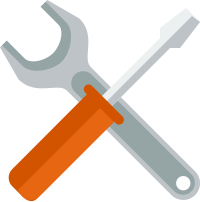
WordPress Glossary
Having trouble understanding some of the WordPress terms used on this or other WordPress-related sites? Read on for a glossary of commonly used WordPress terms and expressions – explained in plain English:
-Note: WinningWP content is free to all. If you make a purchase through referral links on our site, we earn a commission (learn more).
WordPress Glossary:
Common Terms:
- Absolute Path
- A web address that points to the same location or file system regardless of the working directory in which it is written. The absolute path of this page, for example, is https://winningwp.com/wordpress-glossary/ because it will point to the same page (this one) regardless of the location of the file or folder in which it is written.Return to Top
- Action
- A PHP function that is executed at specific points throughout the system. Read more...Return to Top
- Admin Area
- The area of the website that can only be accessed by logging into WordPress, from which content is created, modified or removed and settings changed.Return to Top
- Admin Bar
- (see toolbar)Return to Top
- Administrator
- The highest-level user role within WordPress. Administrators have unrestricted access to the WordPress Admin Area.Return to Top
- Apache
- Apache is a web server application that serves over 55% of all active websites - making it the most commonly used web server application of its kind on the internet. Apache is also widely regarded as about the best server application for publishing WordPress-powered websites.Return to Top
- Attachment
- An attachment is the term used to refer to any media (images, video, etc) used within a post or page.Return to Top
- Atom
- A specific type of format, similar to RSS, used for syndicating content on blogs and news-like sites, viewable by Atom-aware programs called news readers or aggregators.Return to Top
- Autosave
- The act of automatically saving your content as you create it. WordPress autosaves your content as you create/write it (performing an autosave every couple of minutes)! You can see when WordPress last performed an autosave by looking in the lower right corner of the editor, where a notification of when the entry was last saved to the database is displayed.Return to Top
- Avatar
- The small icon, photograph or graphical representation of a user that often appears next to that user's name or comments.Return to Top
- Back End
- Another term for the 'Admin Area'.Return to Top
- Backlink
- An incoming link from a different website to yours. Read more about the importance of backlinks on Wikipedia.Return to Top
- Blog
- A discussion or informational website consisting of a series of discrete entries (commonly referred to as 'posts' or 'articles') - typically displayed such that the most recent entries appear first.Return to Top
- Blogroll
- A list of links to other blogs (usually, but not always, on similar/related topics) - blogrolls are most commonly displayed within the sidebar of a particular blog.Return to Top
- Category
- A special type of predefined WordPress taxonomy used as the primary means of organizing and grouping (i.e. categorizing) WordPress posts of a similar nature.Return to Top
- CDN
- A CDN (Content Delivery Network) is a large distributed system of servers deployed in multiple data centers across the internet (usually in a variety of different countries) used to both reduce the load on any single server and serve content to end-users with increased speed, redundancy and performance.Return to Top
- Child Theme
- A WordPress theme that inherits the functionality of another theme, known as the parent theme. Read more about and how to create them -- and why you should be using one!Return to Top
- Comments
- A feature of weblogs that allows readers to respond to posts by leaving a comment, which, if approved by the author, will be displayed underneath the content of the blog post.Return to Top
- Content
- The text, images, videos or other information contained within the website, typically within the website's posts and pages.Return to Top
- Core
- The main files that make up the WordPress software, excluding the plugins and theme files.Return to Top
- CMS
- A CMS (Content Management System) is a system for creating and managing online content Watch our handy video explanation for more info over on YouTube. Return to Top
- CSS
- CSS (Cascading Style Sheets) is a computer language used to express the presentation (layout, dimensions, colors, etc) of structured documents (usually written in HTML). Bascially, CSS tells the browser how to display the content that makes up each webpage. Read more about CSS on Wikipedia.Return to Top
- Dashboard
- The main administration screen within the WordPress back end. This is the screen that appears after logging in and displays various information through special admin screen widgets that users can enable, disable and move around on the screen. View a screenshot...Return to Top
- Database
- Software used to manage and store information/data. WordPress uses a MySQL database management system for storing and retrieving various information, including the content of you blog and various settings and data used by both the WordPress core and plugins.Return to Top
- Default Theme
- A theme that comes preinstalled with a new WordPress installation.Return to Top
- Dedicated Hosting
- A web hosting service in which the user is assigned his or her own server that's entirely dedicated to running their software and typically has full control over its settings... read more about dedicated hosting on our Beginner's Guide to Choosing the Best WordPress Hosting.Return to Top
- Developer
- Someone who actively creates/develops software (such as WordPress plugins). Often abbreviated to 'dev'.Return to Top
- DIV
- An HTML element generally used for generic organizational or stylistic applications. Read more about the div tag on w3schools.com.Return to Top
- DNS
- The DNS (Domain Name System) is a naming system for resources that connect to the internet. The DNS translates domain names into the numerical IP addresses required for locating computer services, servers and devices worldwide. Read more about the DNS on Wikipedia.Return to Top
- Domain Name
- The part of a network address that identifies it as belonging to a particular domain, e.g. 'winningwp.com'.Return to Top
- Excerpt
- A kind of summary or condensed description of a blog post that typically shows up (provided you've entered one) in search results, RSS feeds and anywhere in the theme that it's been programmed to do so, such as on archive and category pages.Return to Top
- Featured Image
- A specific image that the user can upload that becomes assigned to a specific post or page. This image will then appear in certain predefined positions that are chosen by the developer responsible for coding the particular theme currently in use. Return to Top
- The part of a website normally displayed at the bottom of the webpage.Return to Top
- Framework
- A framework (supporting structure) of code that can be thought of as sitting between the WordPress core and the main files that make up a basic theme. Frameworks aid in both updating and developing themes and often contain a vast amount of functionality that can be easily incorporated into the theme files by a skilled developer. Return to Top
- Front End
- The part of the site that visitors who come to the site see and interact with - as opposed to the back end, which is only visible by those who login to your website. Return to Top
- FTP
- FTP (File Transfer Protocol) is a standard network protocol used to transfer (i.e. upload and download) files between a computer and a server (or from one server to another). To access your WordPress files on a server, you'll need an FTP client, such as Cyberduck (free), Transmit (premium) or Filezilla (free). Read more on choosing the best FTP client?Return to Top
- functions.php
- A file located within a theme that contains a number of PHP functions that enable specific theme-functionality.Return to Top
- Genericons
- A set of free, GPL, vector icons embedded in a web font.Return to Top
- GPL
- The GPL (General Public License) is a type of software license that gives end users (individuals, organizations, companies) freedoms to use, study, share (copy), and modify the software. Read more about the GPL on Wikipedia.Return to Top
- Gravatar
- A globally recognized avatar that's usually associated with a user's email address, such that it may automatically appear wherever that user enters his/her email address (typically used in forums/commenting systems). For more info check out gravatar.com.Return to Top
- Header
- The part of a website normally displayed at the top of the webpage.Return to Top
- Hosting
- A type of hosting service that provides users with their own space on a server connected to the internet, from which to serve files (which may, for example, take the form of a website) to users who can access/view them through specialized software, such as web browsers.Return to Top
- .htaccess
- A hidden file (meaning it is not normally visible through standard FTP client settings) used primarily to configure certain Apache web server software for the directory in which it resides. Read more about htaccess files in Jeff Starrs fantastic Htaccess Made Easy book.Return to Top
- HTML
- HTML (HyperText Markup Language) is the main computer language for creating web pages (and other information) that can be displayed in a web browser. Read more about HTML on Wikipedia.Return to Top
- IP Address
- An IP (Internet Protocol) address is a numerical label assigned to computers, printers, and mobile devices, etc, that connect to the internet through a network that uses the Internet Protocol to communicate. Read more about IP addressed on Wikipedia.Return to Top
- JavaScript
- A commonly used computer language that allows client-side scripts to interact with the user, control the browser and alter the content displayed through the browser. Return to Top
- LAMP
- An abbreviation of 'Linux, Apache, MySQL, and PHP', LAMP is a software bundle composed entirely of free and open-source software, suitable for building high-performance dynamic web sites. Read more about LAMP on Wikipedia.Return to Top
- Linux
- A free and open-source computer operating system that is particularly popular in web server and other high-performance computing environments.Return to Top
- Localhost
- Localhost basically just means 'this computer'. It is a name that the computer's software can use to access the computer's network services. Read more about localhost on Wikipedia.Return to Top
- Loop
- Also known as the 'WordPress loop', the loop is a section of PHP code used to display WordPress posts. Read more about the loop in the official WordPress codex.Return to Top
- Managed Hosting
- Managed hosting is a relatively new concept (largely popularized by the current leaders in the managed WordPress-hosting field: WPEngine) aimed at both taking the hassle out of managing the technicalities of your own server. Read more about managed hosting on our Beginner's Guide to Choosing the Best WordPress Hosting.Return to Top
- MAMP
- (see LAMP)Return to Top
- Media
- In WordPress circles, media usually refers to forms of content other than text, such as images and video.Return to Top
- Meta
- The term meta refers to a concept that is an abstraction from another concept, used to complete or add to the latter. In WordPress, meta refers to administrative type data contained in HTML tags (often read by search engines) that aid in describing and/or defining what the web page is about. Return to Top
- Multisite
- A WordPress feature that allows multiple WordPress sites to share a single WordPress installation. Read more about how to use to create a network of sites in the official WordPress codex.Return to Top
- MySQL
- The world's second most widely used open-source relational database management system.Return to Top
- Open Source
- A development model that promotes both universal access via free license to a product's design or blueprint, and the universal redistribution of that design or blueprint, including any subsequent changes or improvements to it. Read more about open source on Wikipedia.Return to Top
- Page
- A single web page with its own unique URL. WordPress pages tend to be used for content that does not change – such as information about the company/website. Return to Top
- Parent Theme
- A theme with files and/or functionality used by a child theme.Return to Top
- Permalinks
- An unchanging, single URL specifically allocated to a specific web resource (i.e. a page, post, etc) that will continue to point to that same resource indefinitely.Return to Top
- PHP
- PHP is a popular server-side scripting language designed specifically for integration with HTML. WordPress is written using PHP and requires it for operation (Wikipedia).Return to Top
- phpMyAdmin
- A free and open source tool written in PHP intended to handle the administration of a mySQL database through a web browser.Return to Top
- Ping
- (see pong)Return to Top
- Pingback
- A system that allows a blogger to see who has seen the original post and has written their own entry concerning it - provided both authors have pingback-enabled websites (note: pingbacks can be enabled via the 'Discussion Settings' within WordPress). Return to Top
- Plugin
- One or more files containing PHP code that extends the functionality of a standard WordPress installation. Read more...Return to Top
- Pong
- (see ping)Return to Top
- Post
- Content that has been written and published to a blog.Return to Top
- Post Formats
- A specific piece of meta information contained within certain themes that can be used to customize the presentation of a blog post. Read more about post formats in the official WordPress codex.Return to Top
- Post Types
- The types of structured data maintained in the WordPress posts table. Read more about post types in the official WordPress codex.Return to Top
- Post Status
- The current status of certain content within WordPress, such as posts and pages; available statuses include 'published' (viewable by everyone), 'draft' (incomplete post viewable only by logged-in users above a certain user level), or 'private' (viewable only to logged in WordPress users at the administrator level).Return to Top
- Responsive
- Websites that have been designed to provide an optimal viewing experience on any size screen/device.Return to Top
- Robots.txt
- A text file aimed at passing on certain data to the web crawlers and web robots used by search engines to read websites and web pages.Return to Top
- Role
- A designation of WordPress user that determines the level of access a user has to the website. Read more about WordPress roles in the official WordPress codex. Return to Top
- RSS
- RSS (Really Simple Syndication) is a family of web feed formats used to publish frequently updated content – such as blog posts. Return to Top
- Security Keys
- A WordPress security device placed within the site's wp-config.php file. Read more about security keys in the official WordPress codex. Return to Top
- SEO
- SEO (Search engine optimization) is the process of affecting the visibility of a website or a web page in a search engine's organic (unpaid) search results. Learn more about SEO on Wikipedia.Return to Top
- Server
- A computer that is connected to the internet (usually permanently) for the purpose of hosting single or multiple websites.Return to Top
- SFTP
- A more secure version of FTP.Return to Top
- A popular and relatively cheap web hosting service whereby a user's website is placed on the same server as those of multiple other users. Read more about shared hosting on our Beginner's Guide to Choosing the Best WordPress Hosting.Return to Top
- Shortcodes
- Special tags (short bits of code) that allow users to quickly and easily pull bits of predefined functionality into their content. Read more... Return to Top
- The vertical section of a website normally displayed to either the left or right of the main content.Return to Top
- Slug
- A small snail-like creature with no shell...just kidding! A WordPress slug is usually an automatically-generated (although they can be easily edited) URL-friendly version of the post or page title – an ideal slug is usually a few words that best describe a page or post.Return to Top
- Spam
- Any form of obtrusive, unsolicited and unwelcome advertising sent out en masse.Return to Top
- Tag
- A special type of predefined WordPress taxonomy used as a second (the first being WordPress categories) or alternative means of organizing and grouping WordPress posts. Unlike categories, the use of tags is entirely optional.Return to Top
- Tagline
- A short (often catchy) phrase that usually resides under the main title or logo of a blog – usually used to try and convey the character/meaning of the website in only a few concise words.Return to Top
- Taxonomy
- In WordPress, a taxonomy is a subclass used to classify WordPress posts. WordPress has two predefined taxonomies: categories and tags – although it also allows for the creation of, user-defined, custom taxonomies.Return to Top
- Template
- A file used by the theme to define either a complete page or part of a page, such as the header, the sidebar or the footer.Return to Top
- Text Editor
- Software used to edit text files in plain text format, as opposed to binary format (which is the format used by word processing programs, such as Microsoft Word). As any developer will tell you: making the mistake of using program that does not edit files in plain text format, such as Microsoft Word, to edit .html, .css or .php files will cause you serious (often irreversible) problems! There are many excellent text editors available, such as TextWrangler (free), BBEdit (premium), TextMate (premium), Notepad++ (free) and Sublime Text 2 (premium).Return to Top
- Theme
- A set of files used to define both the look and feel of a WordPress website without modifying any of the underlying WordPres core files, i.e. the theme essentially sits above or on top of the WordPress core files, tapping into the their functionality to display both the front end of the website and often, although not always, certain theme-specific-functionality within the back end. Read more... Wondering where to buy the best WordPress themes?Return to Top
- Toolbar
- The horizontal (black) bar that appears at the top of a WordPress site for logged in users and contains a number of useful administration screen links.Return to Top
- Trackback
- An alert that notifies an original author of a blog post that someone else has written an entry concerning their post.Return to Top
- URL
- The term URL (or 'uniform resource locator') refers to the web address of a specific location/resource on the internet – which, in most cases, is displayed within the browser's address bar.Return to Top
- Visual Editor
- The default editor used in the creation of new content within WordPress.Return to Top
- VPS Hosting
- A web hosting service in which users are allocated their own partition on a server with a predefined amount of memory and computational power reserved specifically for that user. Read more about VPS hosting on our Beginner's Guide to Choosing the Best WordPress Hosting. Return to Top
- WAMP
- (see LAMP)Return to Top
- Widgets
- A self-contained area of a WordPress webpage (typically within either the sidebar or the footer) that performs a specific function, such as displaying a calendar or a list of recent posts. The WordPress community has created thousands of new WordPress widgets, many of which can be added via plugins. Read more...Return to Top
- WordCamp
- The name given to all formal WordPress-related conferences – in which people come together primarily to learn more about WordPress and associate with other like-minded people (i.e. people working with or in relation to WordPress). Visit the official WordCamp website to learn more and find out if there's a WordCamp near you!Return to Top
- wp-config.php
- One of the most important files within the WordPress core, the wp-config.php file contains various essential information, such as database connectivity settings and WordPress security keys.Return to Top
- XHTML
- XHTML (Extensible HyperText Markup Language) is essentially a stricter subset of HTML, originally developed to make HTML more extensible and increase interoperability with other data formats. Read more about XHTML on Wikipedia.Return to Top
Enjoyed the above? Read on:
View Other Guides

Good luck!
Although making sense of all the various terms and phrases used in the WordPress world may take a while, knowing at least the basics will likely pay off ten-fold down the line! Good luck!
Love WordPress?
Follow us on Twitter



